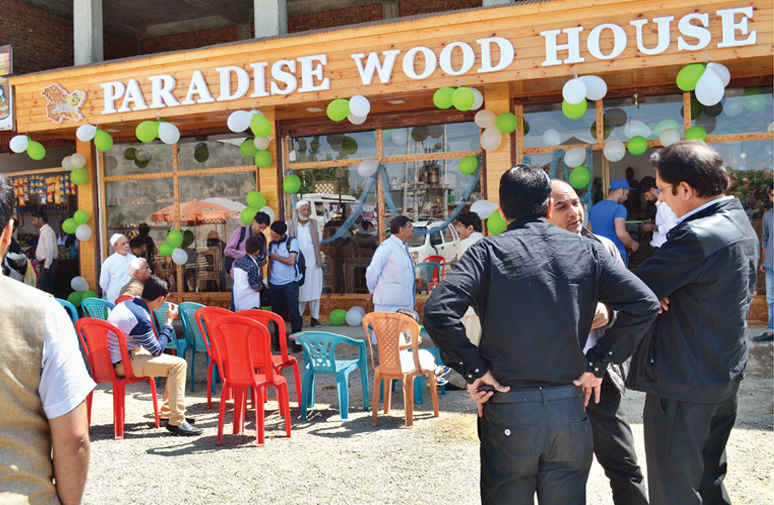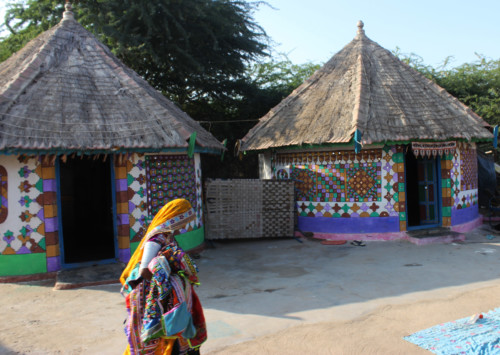Walnut Woodcarving in Kashmir
India & You
March-April 2017

(Above: from left to right) Abdul Ahad, with his work in walnut wood; Sculptures in walnut wood ready for export; (Below: from left to right) in front of a shop in Kashmir; Mohammad Yosuf gives a form of wooden elephant
Kashmir is the valley of artisans, where many arts have found their roots. One such art which remains an integral part of the valley’s culture is the walnut woodcarving. Artisans design and craft various products, which are then sold in international and domestic markets.
As the sunrays fall on the land of this Himalayan region of Kashmir, Abdul Ahad and his younger brother Mohammad Yousuf start their days. Immediately after the morning prayers, the two enter their semi-lit single room to shape walnut wood into different fine artefacts, which would then be the part of decorations in someone’s home.
Starting their day with a cup of noone chai (Kashmiri salted tea), the duo finish the day only after the sun sets behind the tall, snow-clad mountains. Abdul, who has mastered the making of small and fine artefacts from a single piece of wood, has learnt the art from his father and has passed the art to his brother.
Kashmir remains home to some of the best walnut woodcarving in the world and the artisans have the required skill of making almost anything which is in demand across the globe, particularly in the European countries.
Abdul and his family have been into walnut woodcarving and its export for the last 200 years and it remains their legacy. The brothers are said to be best of the artisans among other grand artisans of the state. Abdul, who can’t speak, has wholly devoted his ability to making some of the best artefacts one can come across.
Before the partition of the subcontinent, the family used to export through the Silk Route to the Middle Eastern countries. The partition has now confined their trade mostly to the domestic market. However, the demand for the craft remains high in the international market and many traders export these products to countries like Germany, France, the UK and the US.
Rife European markets
Kashmir is the only part of India where walnut trees are found. Its colour, grain and texture are unique, and the carving and fret work that is done on this wood is of the finest quality, which is what the Europeans love and use as decors in their homes. “The Europeans, particularly the Germans, Brits and French, and the Americans love the detailed and minute works on walnut wood and are ready to pay any cost,” says Mudasir, who runs and exports the walnut woodcraft from Kashmir.
Walnut wood furniture has a global appeal. Wood industry of Kashmir has been brought to the international arena for these excellent types of woodcarving. It enjoys immense popularity and global acclaim.
A variety of products are made from walnut wood, like tables, chairs, writing desks, dining tables etc. and a very fine work of art is being done to make them more artistic. The price of the products may range between EUR 40 and EUR 55,000 depending on the artistry of the carving, its shape, size, intricacy and elaboration of the design.
Dead Wood brought to life
In Kashmir, cutting of the Walnut tree is banned, but, through a legal way, the government provides the big logs to the people who deal in walnut wood and most of the times the wood used are dead wood. But, this dead wood is converted into a lively artefact only by the mastered hands of an artisan, which then becomes a part of the decor in our houses.
“We never run out of wood, as here, in Kashmir, we have abundant walnut wood in our forests and the government provides us the wood, which is then used to make any type of product, whether a furniture or any other artefact,” explains Mudasir.
For an artisan, it takes days to make a single artefact. It all starts with
chiselling out the unnecessary parts and then giving a primary shape to the product. Then, various tools are used to give further finish and shine to the products.











